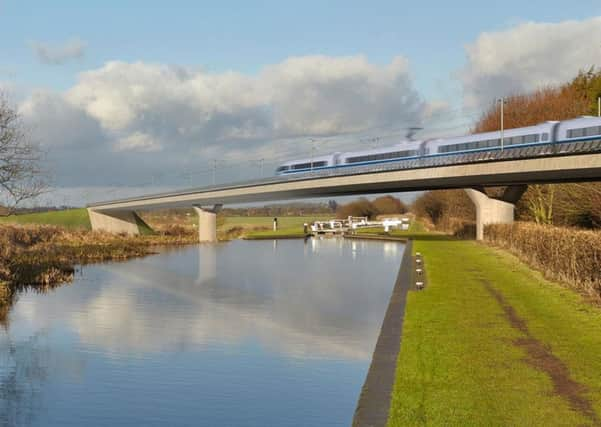Tom Richmond: Time to steer HS2 into the sidings and change track


In my opinion, the Prime Minister should go even further and now put the brakes on HS2, Britain’s high-speed rail revolution, and this advice comes from a columnist who was originally in favour of this scheme because of its potential to free up capacity on existing lines so more trains can operate. The timing could not be more opportune.
Advertisement
Hide AdAdvertisement
Hide AdHS2 chief executive Simon Kirby – Britain’s most expensive civil servant on a £750,000-a-year salary package because of his engineering expertise with Network Rail – is quitting this role to join Rolls-Royce. Recently, he was criticised for refusing to engage with those residents in Yorkshire whose homes might have to be demolished as a result of the proposed route changes.
There’s speculation that Sir David Higgins, the HS2 chairman and the mastermind behind the 2012 Olympics, will not seek a new contract when his current deal runs out next year.
Meanwhile respected experts now think the total bill could virtually double from original estimates to £80bn while Nigel Wilson – chief executive of insurance giant Legal & General which is one of the country’s largest infrastructure investors – has called for Hinkley Point, Heathrow and HS2 all to be scrapped. His is not a lone voice.
It’s probably too much to hope for Mrs May to commit to the miniature nuclear power plants being developed in South Yorkshire, the expansion of Doncaster Sheffield Airport (including a new rail spur to and from the East Coast Main Line) to ease London’s capacity issues and the construction of a super-fast trans-Pennine railway from Hull to Liverpool in one fell swoop. That really would turbo-charge the Northern Powerhouse.
Advertisement
Hide AdAdvertisement
Hide AdThe political and economic landscape is very different to January 2013 when David Cameron trooped his whole Cabinet to Leeds to launch HS2. Nuclear technology is changing so Britain does not have to be reliant on the Chinese; South Yorkshire’s airport has a new access road off the M18 and the terms of the high-speed rail debate are changing.
Three years ago, the priority was improving connectivity between London and the North. However it is clear journey times from Leeds and Sheffield to the capital will be compromised to some extent because of a circuitous route via Birmingham and Heathrow Airport.
Rather than waiting until 2033 at the earliest for the link to Leeds when communications technology may negate the need for business executives to travel to London for face-to-face meetings, there’s a case to be made for tackling – at a fraction of the cost – the pinch-points on the East and West Coast main lines which limit the scope of existing services.
This could be rectified by new signalling outside King’s Cross Station, and an upgrade to the London to Birmingham commuter route, while still enabling all trains to be fitted with 4G wireless technology that provides world-class wi-fi, even in tunnels. It works on Eurostar services deep under the English Channel so why not here?
Advertisement
Hide AdAdvertisement
Hide AdAnd this would still allow the Government to concentrate on building a new railway linking Hull with Leeds, Manchester and Liverpool. Not only is this playing second fiddle to HS2, but the planned electrification of the trans-Pennine line – back on track after last year’s political hiatus – does, in fact, need to be far more ambitious if overcrowding on rush-hour trains is to be eased and congestion reduced on the M62, now one of the country’s largest car parks.
According to the AA, it is 125 miles by road from Hull’s railway station to Liverpool Lime Street – and this journey should take two hours 17 minutes. The fastest weekday train takes a minimum of two and a half hours – and in excess of three hours at busier times. Time it right and it can be just as quick, if not quicker, to travel 185 miles by train from Hull to London. That cannot be right if the North’s potential is to be maximised so it is far more feasible to travel across the Pennines for work purposes.
Equally, it is dispiriting that rush-hour services from Dewsbury to Leeds are now so overcrowded – and unbearable on warm days – that the RSPCA would intervene if cattle were transported like this. I know of one colleague who had to get off at every station last week just to suck in some fresh air and he reports passengers regularly locking themselves into the toilet cubicle to get a seat.
Three years ago, I was among those who said that this generation would not be forgiven if it did not grasp the opportunity to build a North-South railway.
Advertisement
Hide AdAdvertisement
Hide AdNow Britain – and Theresa May’s government – will be letting down the next generation if it does not put HS2 on ‘pause’ so a fresh appraisal can be made of the cost-benefit analysis as each row over the route adds to the final bill.
After all, a high-speed railway across the Pennines, coupled with improvements to the existing North-South railways and the development of state-of-the-art rolling stock built by British train manufacturers, might be the clearest signal yet that Mrs May is committed to representing the interests of all and not just the “privileged few”.